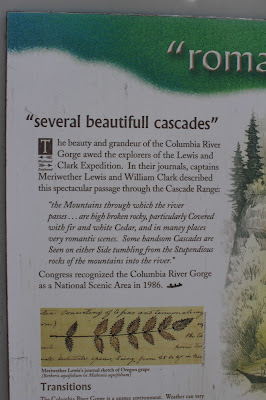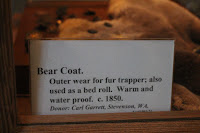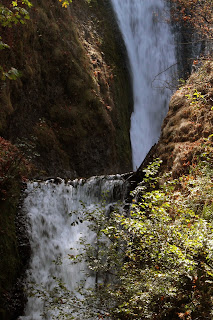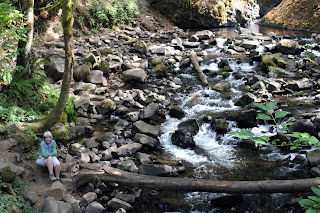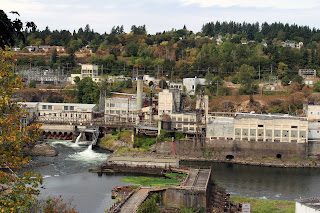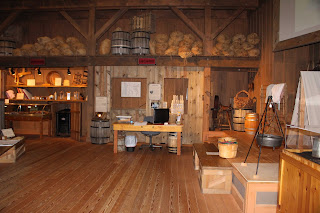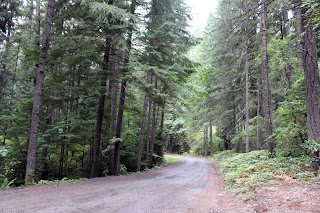NOTE: Best to view blog on computer, however to
view full blog on phone scroll to bottom of the blog and click on “View Web
Version”. Be sure to click on the RV Schedule tab at the top of the page in the
menu bar to see where we will be. You can also enlarge the google map in the
sidebar on the right and click on the markers to view where we have been. If
you want to meet up with us, see the RV Schedule and let us know so we can
spend some time with you!
Portland
Fairview RV Park, Fairview, OR
On August 22, 2015
we arrived at the Portland Fairview RV Park just outside of Portland, Oregon. The park had spacious concrete sites which is
always a plus for easy leveling! It was centrally located to the Columbia River
Gorge and the Greater Portland region. We stayed for two weeks.
The first thing we
found out is that there is no sales tax in Oregon and that you cannot pump your
own gas. Oregon also has legalized
assisted suicide, but have yet to approve same-sex marriage! Analysis of prior presidential
elections has led researchers to conclude that Oregon is one of the most
politically polarized states in America. No wonder there is a different seal on
both sides of the flag.
to Oregon ever since Meriwether Lewis
and William Clark
showed them the way
with their Corps of Discover in 1804.
The Oregon Trail was American’s longest
overland tentacle into the West, and it is estimated over 400,000 settlers traveled
the 2,000 miles by wagon into the Oregon Territory.
So here we are ready for an
adventure!
Mike (“Clark”) and Sharon (“Meriwether”)
will now explore the
Columbia River Gorge that separates Oregon from Washington and was designated
America’s first National Scenic
Area in 1986.
Columbia
River Gorge Scenic Byway
Up to 4,000 feet
deep, the Columbia River is the West’s most majestic river. Troutdale is the
gateway to the scenic byway, which stretches for more than 80 miles as the
Columbia River winds westward through the Cascade range, forming the boundary
between the state of Washington to the north and Oregon to the south. We drove from Troutdale to Hood River to The
Dalles and back again!
On the way home from our scenic drive we stopped at Tippy Canoe where Food Network celebrity, Guy Fieri of Diners, Drive-ins and Dives fame visited with his team to feature the diner on the show.
Columbia
Gorge Discovery Center and Museum
A little more than
10 years after the Historic Columbia River Highway was finished, the face of
the Gorge began to change dramatically.
Bonneville Dam, begun in 1933, raised the water level significantly. The
mighty Bonneville Dam spans the Columbia River linking the two states of
Washington and Oregon. The Bonneville
Dam is the first structure to restrain the mighty Columbia. We visited the
Columbia Gorge Discovery Center and Museum that highlights the history of the
dam, the history of the original people to live in this area of the Gorge – the
Cascade Chinook and the timber and fishing industries in the Gorge.
While the
Northwest gained a powerful supply of electricity and flood control with
Bonneville and later dams, it lost significant historic and prehistoric
resources – most notably traditional Native American fishing sites that were so
critical to their culture. The loss of these cultural sites – and the depleted
salmon stocks – has had a lasting impact on the Native American communities.
Columbia
Gorge Intepretive Center
The Dalles was
long a Native American gathering place and is rich in Oregon Trail lore. As we
entered The Dalles we stopped at the Columbia Gorge Interpretive Center across the river on the Bridge of Gods in Washington. Built as
the interpretive center for the National Scenic Area, the Discovery Center
features the Gorge’s history about the earliest inhabitants and the tales of
the traders and settlers who came later.
The Cascade Chinook, Watlala, Wasco, and Wishram --
Indian bands of the Columbia Gorge -- possessed a
clear understanding of the world.
For everything to be right, each person had to
follow traditions. These passed from generation to
generation through the tales told during the months
of the long moons, the icy times of winter.


Bridge of
the Gods
We crossed the
Bridge of the Gods, a steel truss cantilever bridge that spans the Columbia
River. The overall bridge length is 1,858 feet. The bridge was built in 1926
and takes its name from a Native American myth describing a large natural rock
bridge over the Columbia River at the bridge site. Lewis and Clark came past
the Bridge of the Gods in late October and early November 1805, and again on
their return in mid-April 1806. Both times they were forced to portage around
the Cascade Rapids, a problem which faced travelers for years. In 1896 a
navigational canal and locks were completed at the rapids, and in 1926 the
Bridge of the Gods was completed, providing a link between Oregon and
Washington State.
The Vista
House at Crown Point
The Vista House at
Crown Point is an Oregon treasure, one of the most photographed and
recognizable in the Columbia River Gorge. Built as a memorial to Oregon
pioneers, it offers an inspiring view of the Gorge and the mountains of the
Cascade Range.
The
Waterfalls of the Columbia River Gorge
The most memorable part of the Columbia River Gorge were the
five miles of waterfalls. Although we didn’t see or hike all of the 77 falls,
we did see five of them.
Latourell
Falls
Latourell is a
unique Columbia Gorge waterfall due to the fact it drops straight down from an
overhanging basalt cliff. We hiked to
the lower falls as we weren’t ready to hike a 520 foot elevation gain to the
upper falls. The falls cascaded
beautifully to the pool below and the lichen-covered columnar basalt formations
around the falls was amazing.
Horsetail Falls
This falls was alongside of the road.
Shepperd’s
Dell Falls
This easy hike
along a short paved trail took us to the lower falls. The lower falls is a horsetail formation and
the upper falls is a plunge formation. The falls total height is 220 feet and
it flowed from Young’s Creek.
Bridal
Veil Falls
This was a quick,
nice stroll along a paved trail, circling the top of a bluff in Bridal Veil
Park. There are beautiful views of the
Columbia River.
We left the best
until last. Multnomah Falls is king of the 77 waterfalls on the Oregon side of
the Columbia River Gorge and is the tallest waterfall in the state of Oregon.
At 620 feet, only three falls in the nation are taller, but none are as
majestic as Multnomah Falls. The entire hike is 2.6 miles with an elevation
gain of 700 feet. We hiked .2 miles on a paved trail to the Benson Bridge built
in 1914, where we had a perfect view of the top tiers and a great view over the
second tier’s 69-foot drop.
To get the full experience of Multnomah Falls you need to hike to the top of the falls on the steep asphalt trail with numerous switchbacks. We both started our hike up with our hiking poles and camera in hand, but after the Benson Bridge, Sharon hiked another 1/2 mile and then let Mike continue the balance to the ridge crest without her.
After a short rest, we hiked down to the foot of Multnomah Falls and treated ourselves to an ice cream and sat and watched all of the tourists come and go. It was the most awesome waterfalls we have ever seen, besides Niagara Falls!
Mount
Hood Railroad
Tucked between the
basalt cliffs of the Columbia River Gorge, with Mt. Adams to the north and Mt.
Hood to the south is the Town of Hood River with historic buildings dating back
to 1893. We decided to take a train ride from Hood River to Parkdale which is
known for its apples, pears, blueberries and cherries. As with all of the train
rides we have taken, it never fails to be an overcast, rainy day! But we always
enjoy the adventure!
Seated with us on
the train were a father and son, both Jazz musicians from Coos Bay, Oregon. We
had some interesting conversations during our champagne brunch since we both
love Jazz!
Sites along the way:
We reached our destination in Parkdale:
Snow-capped Mt.
Hood is one of the crown jewels of the Columbia River Gorge standing at 11,239
feet. This ancient volcano reigns as the highest peak in Oregon and is popular
with skiers, hikers and climbers. Glaciers and snowfields conceal a fiery
volcanic past deep in the mountain’s heart. Snow-covered ridgelines beckon in
winter, and wooded trails lead to hidden waterfalls and creeks deep within the
forest.
The 12,276-foot
high Mt. Adams across the border in Washington, is the second highest peak in
the Northwest after Mt. Rainier. Wilderness trails offer hikers magnificent
views of Mt. Adams and its glaciers, plummeting streams, alpine forests and
wildflowers spread among lava flows and rim rocks.
After our train
ride, we took a drive to the Glassometry Studios and Gallery. It is owned by
artist Laurel Marie Hagner. Her 17 years of expertise and creativity has
established the studio professionally in the specialized production of cutting
edge glass and metal sculpture, architectural décor, and everyday wares. Since
it was Sunday, we did not get to meet the artist, but we did admire her works
of art, and Mike got to pet the cat while Sharon browsed.
Culinary
Walking Tour in Portland
The City of
Portland is compact and walkable, with distinctive neighborhoods and great
views of nearby Mt. Hood. We decided to embark on a culinary adventure with Forktown Food Tours (www.forktownfoodtoursportland.com) to learn a little history and eat at some great venues as we strolled along Portland’s
vibrant downtown and the artsy Pearl District.
We made six
delicious stops to eat and drink including the following:
Our first stop was
the Picnic House which serves as a
lovely gathering spot for locals for lunch with black and white floors, soaring
ceilings and elegant woodwork throughout. Here we enjoyed a glass of wine while
our tour guide introduced herself.
Next, was the Savor Soup House which features soups
ranging from classic to creative using the best local products. We enjoyed a delicious
taste of the soup de jour -- Tomato with Fennel and Orange -- as we stood along
one of the largest food cart pods in town. Bon Appetit magazine raved about
Portland’s food cart culture, and CNN declared the city home to the world’s
best street food. The city has about 700 licensed food carts, with quality
offerings from Moroccan seafood paella to French sweet and savory crepes full
of smoked salmon or asparagus. It would have been decadent just to eat at every
cart for a whole day!!
Chef Rick Gencarelli
got his start as a food cart vendor, but now he sources local and high quality
ingredients at his popular sandwich shop called Lardo. Here we enjoyed a glass of beer, burger and fries.
Next we stopped at
Cacao’s on 13th Avenue which
provided 100% chocolate bars from around the world, and a thick demitasse hot
chocolate to die for, so delicious we had to buy a jar for those cold winter
nights!
We concluded our
foodie tour with desert at Petunia’s Pies and Pastries. As if we weren’t full
already, there is always room for desert!
During our walk,
we also passed some interesting old landmarks.
Portland lives up to its unofficial motto “Keep Portland Weird” and is
worth a visit. We highly recommend a food tour with Fork Town Food Tours!
During the food
tour, we passed Portland’s famous Powell’s City of Books, the self-proclaimed
“world’s largest new and used bookstore”.
So after the tour we went back to explore the bookstore! The sprawling
building occupies an entire city block with three floors and 3,500 separate
sections holding more than 1.5 million books. Mike headed to the rock hounding
book section and Sharon browsed the jewelry book section, both of us came away
with a purchase! If you like books,
don’t miss this stop!
Union Station
There are several bridges into Portland so we took the Morrison Bridge.
We parked and walked to see Union Station which was a hub of activity.
Another must do in
Portland is a stop at Voodoo Doughnut. The selection includes donuts drizzled
with toppings like Butterfingers, Cap’n Crunch and, yes, bacon. It was a
guaranteed sugar high and breakfast of champions!
Oregon Historical
Society Museum
Next we toured the
Oregon Historical Society Museum which was created in 1898 and receives about
44,000 visitors annually. The museum features three floors of exhibitions on
the people, places, and events that have shaped Oregon and the world. The
permanent exhibition on the third floor is Oregon My Oregon, which details the
history of the state.
Imagine...the first air mattress/waterbed was used in 1849.
Lan Su
Chinese Garden
We also took a
guided tour of the Lan Su Chinese Garden, a tranquil refuge amid the urban
blocks of Old Town Chinatown. One of the most authentic classical Chinese
gardens outside the People’s Republic, this “Garden of Awakening Orchids”
mirrors those in Suzhou, with hundreds of plants native to China as well as a
traditional teahouse. It was a beautiful interplay of architecture, plants,
poetry rocks and water surrounding them.
The Hall of
Brocade Clouds is traditionally where the family met and entertained guests.
The intricately-carved gingko panels depict an important collection of plants
known as the Three Friends of Winter: plum, bamboo and pine. The plum braves
the cold of winter to blossom; the pine stays green throughout the cold season;
and the bamboo bends in storms, but does not break.
All aspects of
nature in the garden – from plants and animals to the changing of seasons –
offer an endless source of contemplation. Meditation, discussion and
storytelling were popular activities in Chinese gardens.
The Lake Tai Rocks
below are brought over from China and are highly prized. Formed underwater over
the course of many decades, the lake’s acidic and active waters erode some
stone, leaving fantastic shapes.
Multiple
generations lived within the garden and its surrounding buildings. In the room
called Reflections in Clear Ripples, also known as the lounge house, people
would gather for music, painting or playing games such as mahjong.
The six panels
below are carved by artisans from gingko wood brought over from China and
illustrate actual gardens in the sister city of Suzhou. On the back of the
fourth panel are the words of an influential painter, calligrapher, scholar and
garden connoisseur Wen Zhengming (1470-1559): “Most cherished in this mundane
world is a place without traffic; truly in the midst of a city there can be
mountain and forest.” Centuries later, these words still ring true.
The Scholar’s
Courtyard is an extension of the study and a quiet place for reflection and
inspiration. The plum trees near the entrance blossom in late winter, and
symbolize resilience and revival. The plum motif is repeated in the mosaic
floor pattern called “plum blossoms on cracked ice.” The Scholar’s Study was where men in the family prepared for grueling examinations. Success would allow them to serve in government, a highly desired career. It served as a place to apply their learning in poetry, calligraphy, painting and to admire art and entertain fellow scholars. The scholar’s tools and furniture were selected for practical value, to inspire creativity and to display his taste to visitors.


Along the roofline
are bat-shaped drip tiles. Each tile is adorned with five bats, representing
the five blessings – long life, fortune, health, a love of virtue and a
painless passing.
The Tower of
Cosmic Reflections serves as a teahouse promoting the social art and culture of
tea. Women in the family managed the household and finances, and were also seen
as the protectors of cultural heritage. Much of their time would be spent here
and the “inner courtyard” of the garden.
The rockery is designed to appear as rugged mountains in the distance, complete with waterfalls and cascading streams. The inscription on the rock mountain translates to "Ten Thousand Ravines Engulfed in Deep Clouds."
Oregon
City
Overlooking
thundering Willamette Falls, Oregon City lures you with its authentic heritage,
unique nature setting, and a bustling Main Street. It even features a municipal
elevator.
From the early days, fish were important to the way of life for Oregonians. That's why they preserved their native salmon and lamprey with a North Fish Bypass, paths over flashboards and inflatable bladders that provided a safe passage over the falls. It helped more than 98 percent of fish swimming through the T.W. Sullivan plant to survive.
Willamette Falls
is, by volume, the largest waterfall in the Pacific Northwest and is second
only to Niagara Falls in North America. Native American legends taught that the falls
were placed there by a great god so that their people would have fish to eat
all winter. Many local tribes built villages in the area because of the
abundance of salmon which could only pass the falls at certain water levels.
Native Americans still harvest Pacific Lamprey at the falls each year in the
early summer.
First we stopped
at the Museum of the Oregon Territory.
Dr. John McLoughlin was born in 1784 in the province of Quebec. In 1803, at the age of 18, he completed his studies and became a doctor in medicine. He was hired as a physician by the North West fur trading company and would become a partner in the company. In 1824, after the North West Company merged with the Hudson's Bay Company three years earlier, McLoughlin was appointed as the Chief Factor of the Columbia District, which was the British name for the Oregon Country. In 1829, McLoughlin secured a land claim at Willamette Falls on behalf of the Hudson's Bay Company. With no government in the region, McLoughlin was the most powerful person in the Oregon Country. He was instructed by the company to discourage American settlement, but being a businessman and a humanitarian McLoughlin welcomed, aided, and gave land to Americans who likely would not have survived their first winter without his assistance.
 In 1842, fearing his land claim at Willamette Falls would be disputed, he hired Sidney Moss to survey and plat his claim and named the town "Oregon City," which would become the first incorporated city west of the Rocky Mountains in 1844.
In 1842, fearing his land claim at Willamette Falls would be disputed, he hired Sidney Moss to survey and plat his claim and named the town "Oregon City," which would become the first incorporated city west of the Rocky Mountains in 1844.
McLoughlin made a second plat of Oregon City in 1850. McLoughlin also oversaw the construction of Oregon's first lumber mill, encouraged Oregon's first schools and churches, and became an American citizen and the mayor of Oregon City. Due to all of these contributions, in 1957, 100 years after his death, the Oregon Legislature bestowed upon McLoughlin with the title of "Father of Oregon."
Oregon City was
the first plat map of a city in the Oregon Territory in 1842; the first incorporated
city west of the Rocky Mountains in 1844 and also had the first paper mill in
1866. Our docent worked at the paper mill pictured below, just across the river.
Next, we stopped
at the End of the Oregon Trail Museum
to learn about the history of the Oregon Trail, Clackamas County and Oregon
City – the western terminus of the Oregon Trail.
Early settlers who
arrived by ship or on horseback established a commercial and industrial center
on the land near the falls. Their numbers increased substantially with the
arrival of the first wagon trains over the Oregon Trail in 1842.
Our tour included
the beginning of their journey and what the families left behind as they began
their 2,000 mile journey; a film that traces the experiences of pioneers headed
for Oregon; and the end of the journey.
Rock Hounding on the Clackamas River
Our most memorable
rock hounding excursion in this area was in the Mount Hood National Forest on the Clackamas River in the
Willamette Valley area. According to our Oregon rock hounding book the river is
well known for finding quartz, agate, jasper and petrified wood. Armed with our
buckets, tools, water bottles and gloves and Sharon took her camping stool
too (and later left it beside the car thinking Mike would load it in the Jeep...but it was left behind)! Not knowing exactly how to identify
a lot of rocks, we did find some red, green and brecciated jaspers and some
white quartz which Mike would later tumble.
After several hours our buckets were full of treasures. Before getting to our location we passed through the Town of Boring and the Town of Scotland and saw this funny sign!
We also stopped
alongside the road near Lake Harriet where Mike read about finding zeolite
inside volcanic basalt rocks. He took his hammer and by this time it was
raining, but he carried on! He hammered
several rocks open which turned out to be loaded with voids – also known as
vugs -- containing calcite and zeolite.
We also stopped at
Ed’s House of Gems on our way back home and picked up a few jewelry tools and
Mike picked up a rock hounding book.
We are headed to Brookings,
Oregon along the Pacific Coast. Stay tuned for our next blog post!
Mike & Sharon
“…to
find the air and the water exhilarating…to be thrilled by the stars at night;
to be elated over a bird’s nest or a wildfower in the spring – these are some
of the rewards of the simple life.”
John
Burroughs
